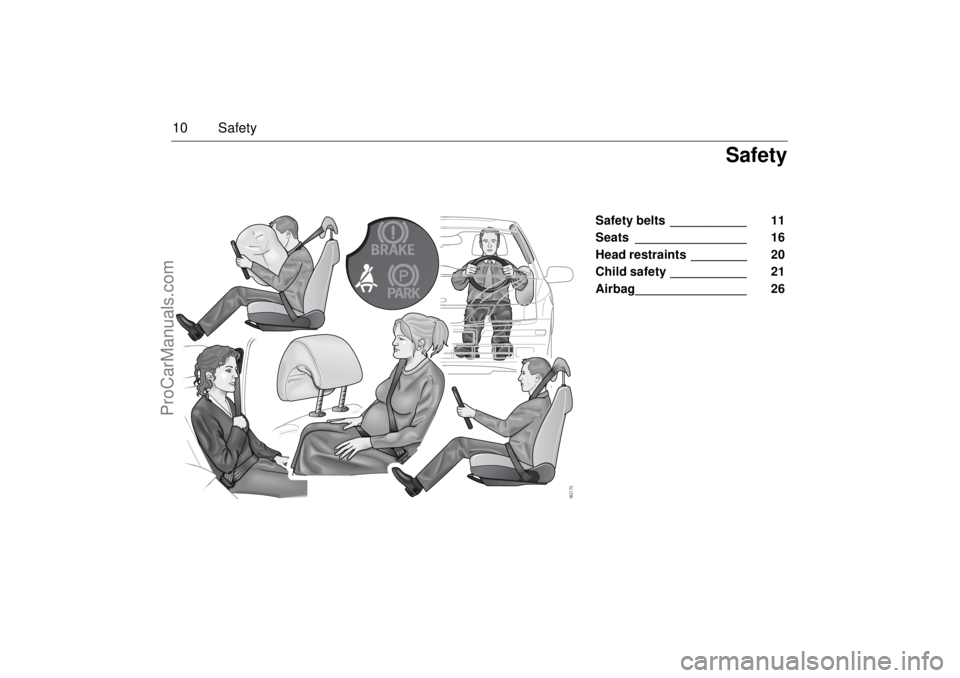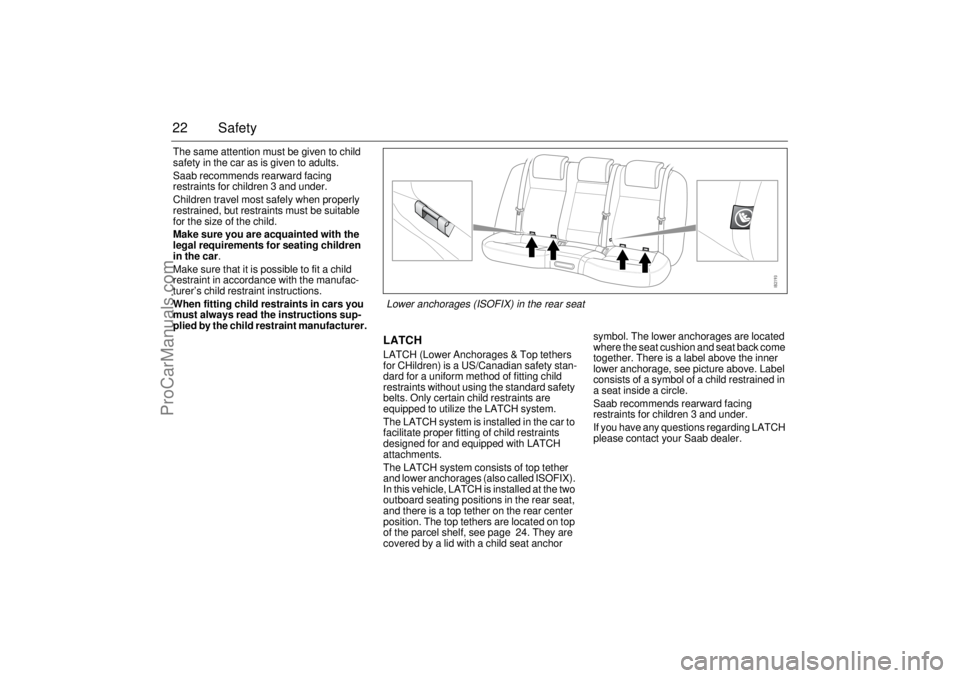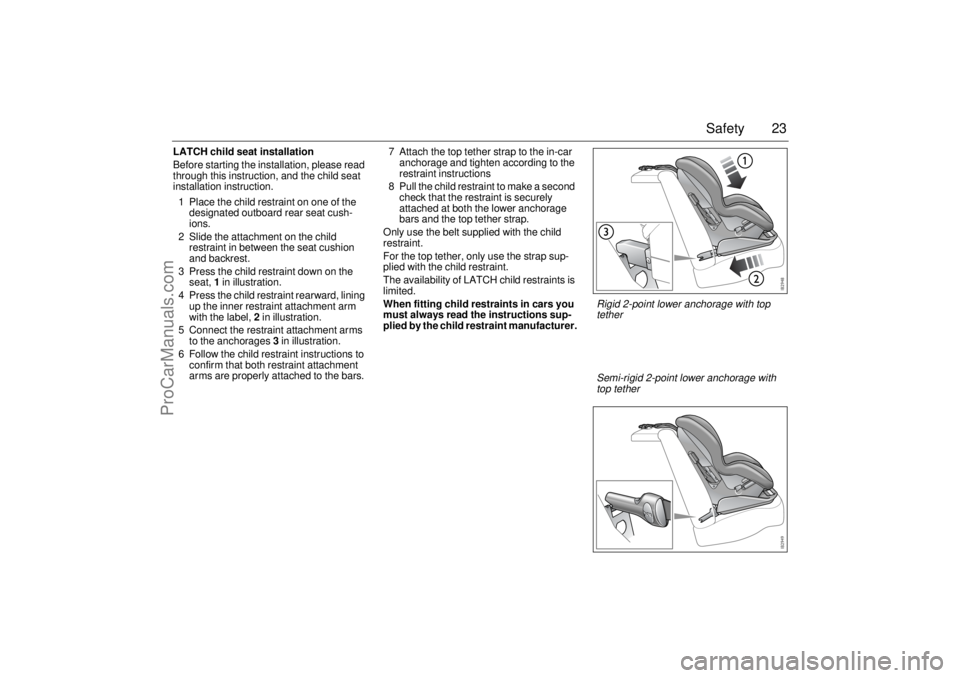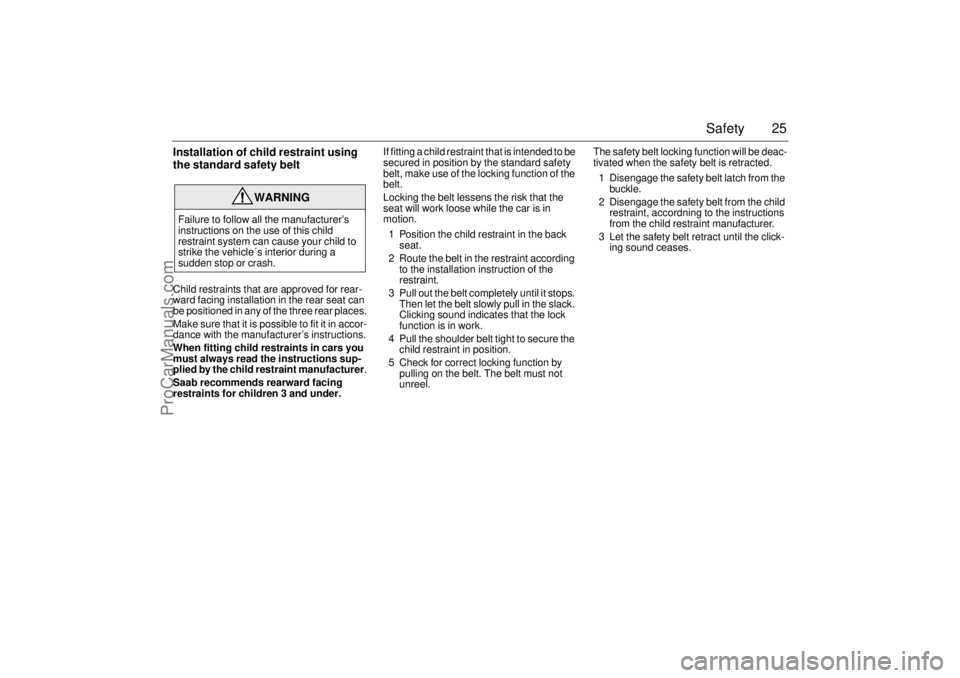2003 SAAB 9-3 child restraint
[x] Cancel search: child restraintPage 8 of 256

8
Long loads:Always secure load to prevent it
from shifting during transport.
An unsecured load could cause
passenger injuries in braking situa-
tions or in the event of a crash.
Changing wheels:Use on level ground only. Use vehicle
support stands. Safe working load
1980 lbs. (900 kg).
Contact a Saab dealer if a
xenon headlight requires
replacement.
This label is only found on
cars with xenon headlights.
DEATH or SERIOUS INJURY can occur Children 12 and under can be killed by the air bag
The BACK SEAT is the SAFEST place for children
NEVER put a rear-facing child seat in the front
Sit as far back as possible from the air bag
ALWAYS use SEAT BELTS and CHILD RESTRAINTSUSA
CANADA
Jack Jack is designed only for changing a tire or mounting
tire snow chains.
Vehicle must be level and jack must be placed on firm
and level ground.
Never crawl underneath vehicle when it is jacked up.
JACKING INSTRUCTION
1 Set parking brake and shift transmission to park.
2 Fit top of jack into jacking point next to wheel to be
changed.
3 Crank jack so that vehicle begins to lift.
4 Using socket wrench in tool kit, loosen wheel bolts
one-half turn.
5 Raise vehicle so that tire clears ground. Loosen
wheel bolts completely and remove wheel.
6 Mount spare wheel and tighten bolts enough so
wheel is not loose.
7 Lower vehicle. Tighten wheel bolts in a crisscross
sequence.
ProCarManuals.com
Page 10 of 256

10 Safety
Safety belts ___________ 11
Seats ________________ 16
Head restraints ________ 20
Child safety ___________ 21
Airbag________________ 26
Safety
ProCarManuals.com
Page 21 of 256

21 Safety
Child safety
Protect your children from getting
trapped in the trunk of a car
WARNING
Children must always be suitably
restrained in the car.
DEATH or SERIOUS
INJURY can occur
Children 12 and under or
shorter than 55 inches
(140 cm) can be killed by the airbag
The BACK SEAT is the SAFEST place
for children
NEVER put a rear-facing child seat in
the front
Sit as far back as possible from the
airbag
ALWAYS use SAFETY BELTS and
CHILD RESTRAINTS
WARNING
Never leave your children unattended
in a car, even for a short time.
– Children can suffer heat stroke,
perhaps die, in a matter of minutes.
– Children can put the car into gear and
hurt themselves or others.
At gas stations, take the remote
control from the car while filling the
tank.
Never allow children to climb on top of
or under motor vehicles.
Always look for children before back-
ing your motor vehicle out of a garage
or driveway.
To avoid carbon monoxide poisoning,
never let a car idle in the garage.
Supervise young children around
buckets of water while washing your
car. Small children can drown in
seconds in less than an inch of water.
WARNING
Teach your children not to play in or
around cars.
Watch your children when loading or
unloading the car so they don´t get
locked in by mistake.
Always lock the doors and trunk of
your car, and keep the keys out of chil-
dren´s sight and reach.
Keep the rear fold-down seat closed to
help prevent children from getting into
the trunk from inside the car.
ProCarManuals.com
Page 22 of 256

22 SafetyThe same attention must be given to child
safety in the car as is given to adults.
Saab recommends rearward facing
restraints for children 3 and under.
Children travel most safely when properly
restrained, but restraints must be suitable
for the size of the child.
Make sure you are acquainted with the
legal requirements for seating children
in the car.
Make sure that it is possible to fit a child
restraint in accordance with the manufac-
turer’s child restraint instructions.
When fitting child restraints in cars you
must always read the instructions sup-
plied by the child restraint manufacturer.
LATCHLATCH (Lower Anchorages & Top tethers
for CHildren) is a US/Canadian safety stan-
dard for a uniform method of fitting child
restraints without using the standard safety
belts. Only certain child restraints are
equipped to utilize the LATCH system.
The LATCH system is installed in the car to
facilitate proper fitting of child restraints
designed for and equipped with LATCH
attachments.
The LATCH system consists of top tether
and lower anchorages (also called ISOFIX).
In this vehicle, LATCH is installed at the two
outboard seating positions in the rear seat,
and there is a top tether on the rear center
position. The top tethers are located on top
of the parcel shelf, see page 24. They are
covered by a lid with a child seat anchor symbol. The lower anchorages are located
where the seat cushion and seat back come
together. There is a label above the inner
lower anchorage, see picture above. Label
consists of a symbol of a child restrained in
a seat inside a circle.
Saab recommends rearward facing
restraints for children 3 and under.
If you have any questions regarding LATCH
please contact your Saab dealer.Lower anchorages (ISOFIX) in the rear seat
ProCarManuals.com
Page 23 of 256

23 Safety
LATCH child seat installation
Before starting the installation, please read
through this instruction, and the child seat
installation instruction.
1 Place the child restraint on one of the
designated outboard rear seat cush-
ions.
2 Slide the attachment on the child
restraint in between the seat cushion
and backrest.
3 Press the child restraint down on the
seat, 1 in illustration.
4 Press the child restraint rearward, lining
up the inner restraint attachment arm
with the label, 2 in illustration.
5 Connect the restraint attachment arms
to the anchorages 3 in illustration.
6 Follow the child restraint instructions to
confirm that both restraint attachment
arms are properly attached to the bars.7 Attach the top tether strap to the in-car
anchorage and tighten according to the
restraint instructions
8 Pull the child restraint to make a second
check that the restraint is securely
attached at both the lower anchorage
bars and the top tether strap.
Only use the belt supplied with the child
restraint.
For the top tether, only use the strap sup-
plied with the child restraint.
The availability of LATCH child restraints is
limited.
When fitting child restraints in cars you
must always read the instructions sup-
plied by the child restraint manufacturer.
Rigid 2-point lower anchorage with top
tether
Semi-rigid 2-point lower anchorage with
top tether
ProCarManuals.com
Page 24 of 256

24 SafetyChild tether anchorages for forward
facing child seatsChild restraints with a tether strap must be
attached according to Canadian and U.S.
safety standards.The car is provided with three top tether
anchorages. Use the one that is right behind
the child restraint and attach the restraint as
follows:
1 Open the cover that is right behind the
child restraint, 1 in illustration.
2 Place the child restraint in the rear seat.
3 Secure the lower part of the child
restraint by means of the lower anchor-
ages (ISOFIX) or the safety belts as
described in the child restraint installa-
tion instruction.
4 Lower the headrest and route the tether
over it.
5 Attach the tether to the anchorage, 2 in
illustration.
6 Close the cover to the middle position, 3
in illustration.7 Tighten the tether so that the back of the
child restraint is pressed hard against
the backrest.
8 Pull the child restraint to make a second
check that the restraint is securely
attached at both the lower anchorages
bars on the safety belts and the top
tether strap.
WARNING
Child top tether anchorages are designed
to withstand only those loads imposed by
correctly fitted child restraints.
Under no circumstances are they to be
used for adult safety belts.
Child tether anchorages in parcel shelf
ProCarManuals.com
Page 25 of 256

25 Safety
Installation of child restraint using
the standard safety beltChild restraints that are approved for rear-
ward facing installation in the rear seat can
be positioned in any of the three rear places.
Make sure that it is possible to fit it in accor-
dance with the manufacturer’s instructions.
When fitting child restraints in cars you
must always read the instructions sup-
plied by the child restraint manufacturer.
Saab recommends rearward facing
restraints for children 3 and under.If fitting a child restraint that is intended to be
secured in position by the standard safety
belt, make use of the locking function of the
belt.
Locking the belt lessens the risk that the
seat will work loose while the car is in
motion.
1 Position the child restraint in the back
seat.
2 Route the belt in the restraint according
to the installation instruction of the
restraint.
3 Pull out the belt completely until it stops.
Then let the belt slowly pull in the slack.
Clicking sound indicates that the lock
function is in work.
4 Pull the shoulder belt tight to secure the
child restraint in position.
5 Check for correct locking function by
pulling on the belt. The belt must not
unreel.The safety belt locking function will be deac-
tivated when the safety belt is retracted.
1 Disengage the safety belt latch from the
buckle.
2 Disengage the safety belt from the child
restraint, accordning to the instructions
from the child restraint manufacturer.
3 Let the safety belt retract until the click-
ing sound ceases.
WARNING
Failure to follow all the manufacturer’s
instructions on the use of this child
restraint system can cause your child to
strike the vehicle´s interior during a
sudden stop or crash.
ProCarManuals.com
Page 30 of 256

30 Safety
Front passenger seatThe system is the same as that used on the
driver’s side.
The airbag systems are interconnected and
have a common warning light . The pas-
senger airbag module is housed in the
fascia above the glove compartment and is
marked "AIRBAG".
Both airbags will be inflated in the event of a
moderate to severe frontal, or near-frontal
crash, even if the passenger seat is unoccu-
pied.
The car is equipped as standard with
a passenger airbag.
WARNING
Never secure a rear-facing child seat in
the right front seat of a car equipped with
a passenger airbag. Inflation of the airbag
in the event of a crash could seriously
injure or kill a child.
WARNING
DEATH or SERIOUS
INJURY can occur
Children 12 and under or
shorter than 55 inches
(140 cm) can be killed by the airbag
The BACK SEAT is the SAFEST place
for children
NEVER put a rear-facing child seat in
the front
Sit as far back as possible from the
airbag
ALWAYS use SAFETY BELTS and
CHILD RESTRAINTS
Never allow a child to stand in front of
the seat or to sit on the lap of a front
seat passenger. Serious injury or
death could result if the airbag is
inflated in a crash.
The glove compartment must be
closed while travelling. An open glove
compartment door could cause leg
injuries in the event of a crash.
Never place anything on the dash or in
front of the seat as, in addition to being
a hazard to passengers, this could
interfere with the function of the airbag
in the event of a crash. The same
applies to the mounting of accessories
on the dash.
Operation of the steering wheel airbag in
a front-end crash
Moment of impact.
Sensors detect a
decelleration and send
a signal via the control
module to a gas gen-
erator that inflates the
airbag.
The inflating airbag
cushions the driver.
Airbag now fully
inflated.
The airbag starts to
deflate.
ProCarManuals.com